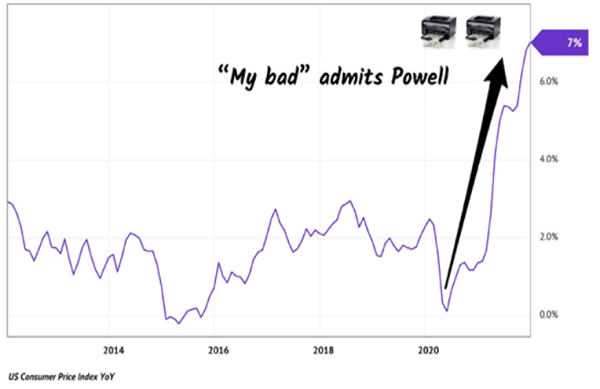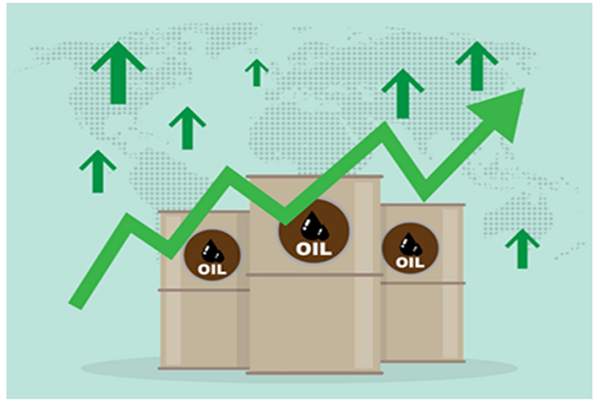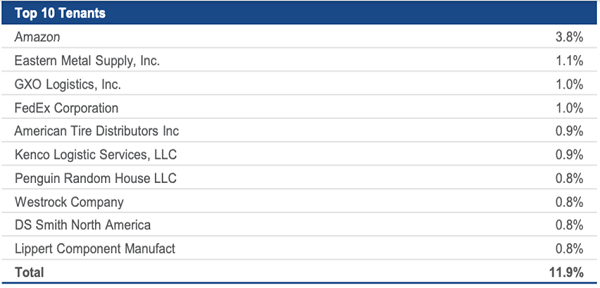The crowd is about to pile into monthly dividend stocks, and we’re going to beat them to it with three of the best of them—and grab ourselves hefty yields up to 6.5%, too.
The three monthly payers we cover below will be very appealing to folks who are getting shaken down as the S&P 500—and especially the tech-heavy NASDAQ—crumble.
Dividends—even monthly ones—normally get a collective yawn from investors in bullish times. But they’ll be darlings this year as Jay Powell switches off his money printer to try to clean up an inflation mess of his own making.
Jay’s Money Printer Works a Little Too Well

Meantime, “regular” stocks and Treasuries still dribble out sorry payouts way south of 2%. And if our “NASDAQ refugees” sit in cash, they know full well they’ll be sitting right in inflation’s tracks!
But with monthly dividends, they can grab inflation-offsetting payouts that roll in every 30 (or 31) days. That’s a huge plus in any market because if you don’t need the cash to pay your bills, you can reinvest it fast, bulking up your holdings (and your income stream) as you do.
With the three tickers below, we’ll be in well ahead of time as the mainstream crowd suddenly discovers the virtues of a “boring” monthly payout.
Monthly Dividend Play No. 1: A Canadian “Inflation Killer” Yielding 6.5%
Let’s start off north of the border with pipeline firm Pembina Pipeline (PBA). It’s an ideal inflation hedge, as it benefits as rising oil and gas prices prompt shippers to boost production back to pre-pandemic levels, something the Canadian Association of Energy Contractors expects to happen later this year.

Plus, Pembina pays an outsized 6.5% and, unlike US pipeline players such as Energy Transfer LP (ET), Enterprise Products Partners (EPD) and Kinder Morgan (KMI), Pembina pays us every single month.
And that payout is reliable—Pembina has paid a dividend since 1997, and it’s done something highly unusual for a 6.5%-payer: raise its payout, and by no small amount, either: in the last 10 years, the firm’s dividend has jumped 61% (in Canadian dollars).
The company boasts 11,000 miles of crude, natural gas and condensate pipelines throughout Canada. It also ships into the US, with natural gas, ethane and condensate running across the border to Illinois through its Cochin pipeline, which it purchased from Kinder Morgan in 2019.
Higher oil production and prices in Western Canada are boosting Pembina’s balance sheet, which boasts reasonable long-term debt equal to about 35% of assets. Its dividend accounts for 73% of free cash flow—reasonable for a pipeline with Pembina’s predictable revenue. The company also plans to buy back about $1 billion of its shares this year.
The kicker is that this stock can be had for just 16-times forward earnings, a nice discount to its pre-pandemic level of 23.
Pembina pays dividends in Canadian dollars, so you’ll see some fluctuation in your monthly payouts. However, the Bank of Canada will likely shy away from raising interest rates much faster than the Federal Reserve, to avoid inflating the value of the “loonie.” That should keep your payouts stable. Plus, Pembina trades on the NYSE, so it’s easy to buy.
Monthly Dividend Play No. 2: An “Inflation-Proof” E-Commerce Pick
STAG Industrial (STAG) is another smart inflation play—the value of its properties is rising and it’s collecting higher rents: in Q3, it rented 3.7 million square feet at 8% higher rents (on a cash basis) than previous tenants paid, and 14.7% on a straight-line basis, which spreads rent over the entire lease term, factoring out one-time costs and incentives.
Then there’s the shift toward buying “stuff” and away from services, which is likely to stick with us, even as the pandemic eases. STAG has that angle covered, with tenants like Amazon.com (AMZN)—its largest tenant—FedEx (FDX) and GXO Logistics (GXO).

Source: STAG Industrial Fall 2021 investor presentation
We also love the job management’s done in de-risking STAG’s operations, making sure no one tenant accounts for more than 3.8% of annualized base rent (as you can see above). Moreover, 84% of its tenants have revenue above $100 million, and 64% boast revenue over $1 billion, so it’s dealing with very secure companies.
Back to the dividend—the monthly payout yields 3.4% now, which is obviously less than Pembina’s outsized 6.5% yield. But it is still nearly triple the payout on the typical S&P 500 stock, well above the 1.8% Treasuries pay and is safe at 72% of STAG’s last 12 months of funds from operation (FFO, the main REIT cash-flow metric). And like Pembina, STAG regularly bumps its dividend higher, with a 22% increase over the last eight years.
The stock trades at 21.3-times trailing-12-month FFO, which is fair for a stock that gained 41% in the last year while paying—and raising—its monthly payout. With a huge 15% gain in FFO in Q3, a stellar 97% occupancy rate and tailwinds from e-commerce and a rebounding economy, its gains are just getting started.
Monthly Dividend Play No. 3: A 6.4% Dividend With a Hidden Edge
Finally, the BlackRock Enhanced Global Dividend Trust (BOE) offers us international exposure, particularly to Europe, where markets have underperformed their US cousins, going by the Vanguard FTSE Europe ETF (VGK):
Europe Lags, Giving Us an Opportunity

BOE gives us a nice balance, with 50% of its holdings in the US and 50% overseas, with Europe and the UK accounting for about 36% of the total portfolio. The fund has a mandate to hold at least 40% of its portfolio in foreign stocks, so the fact that it currently holds 50% is a show of management’s bullishness.
Nonetheless, BOE, which yields 6.5% today, trades at a 9.1% discount to net asset value (NAV, or what its portfolio holdings are worth). That means we’re basically getting these stocks, including Microsoft (MSFT), France-based pharma giant Sanofi SA (SNY) and British spirits maker Diageo (DEO), for 91 cents on the dollar!
We also benefit from BOE’s option-selling strategy, which bolsters its dividend and cuts its volatility. Under this plan, management sells covered-call options on the fund’s portfolio, which give buyers the option to buy its stocks at a fixed price on a fixed date.
If the stock doesn’t hit that price, the fund keeps the cash. If it does, the stock gets “called away” but the fund still keeps the cash! This is a savvy strategy that does particularly well in volatile markets like today’s.
This “7% Monthly Dividend Portfolio” Is Your Ticket to Steady Gains in 2022
My “7% Monthly Dividend Portfolio” is a key inflation-protection tool you won’t want to be without. It’s a set of stocks and funds I’ve collected from across the economy that all share two things:
- Sky-High dividends: a 7% average payout (with growth potential) is exactly what you need to fend off inflation and skate over volatile markets. Because with dividends that big coming your way every year (paid monthly!), you can tune out the market’s daily gyrations.
- Bargain valuations: All of these stocks and funds are overlooked, which means they’re primed to soar in a rising market and hold their own as volatility picks up, as we expect it to as 2022 wears on. That means you can sit back and collect your 7%+ payouts in peace!
With the Fed taking away the punchbowl and stocks throwing a tantrum, there’s never been a better time to hold a collection of rock-solid 7%+ monthly dividend payers. Click here and I’ll give you the “keys” to this revolutionary portfolio. You’ll learn all about every stock and fund inside, including their names, tickers, current yields and best buy prices.
